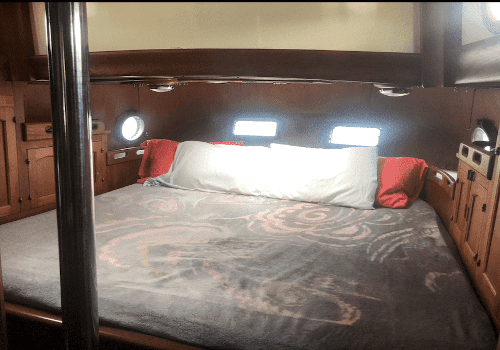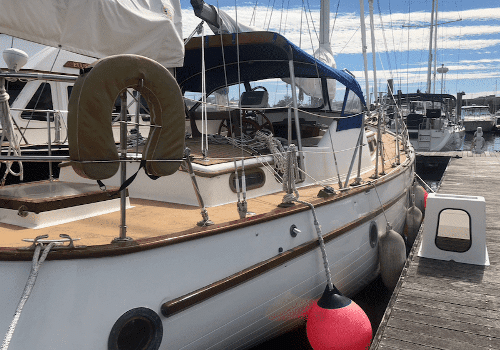Sign up with NauticEd for FREE (no obligation) and receive 2 free boating courses, a free eLogbook and boating resume, and more! If you want to get started in boating or are experienced and want to expand your knowledge and skills, consider taking our many online sailing and powerboating courses.
Aft Cockpit vs. Center Cockpit: What Actually Matters
Choosing between an aft cockpit and a center cockpit isn’t just about layout—it’s about how you use the boat, what you value in living space, and where you sail. I’ve had both, worked on a ton, and cruised enough to know there’s no perfect answer—just trade-offs that you need to be honest with yourself about.
The Center Cockpit: Private Aft Cabin, Smaller Cockpit
Let’s start with the obvious: center cockpits typically give you a big aft cabin. That separation between living space and sleeping quarters is genuinely nice. You get privacy, space to stretch, and even heating flexibility—turn the heat down in the main cabin and up in the aft for sleeping, saving power or fuel.
Visibility is generally better up higher, and many setups have the mainsheet right behind the helm—great for quick adjustments. You’re closer to the spring lines too, which helps when docking short-handed. If the design is right, reefing and trimming can be easier from the helm. And yeah, center cockpits are easier to fully enclose, so if you’re sailing through shoulder seasons or in colder climates, that enclosure is worth gold.
But let’s be real. Below 40 feet, center cockpits can look a bit awkward. The cockpit is usually smaller, and the saloon feels tighter—sometimes gloomy. You also get these tight corridors from the saloon to the aft cabin. The added height and freeboard can increase windage and give you visibility issues under a genoa. And no one talks about how annoying it is to use an emergency tiller on some of these boats. Hint: it’s bad.
Also, getting off and on the boat isn’t as slick. You’re climbing up and over from the dock or dinghy—not ideal if you’re hopping on and off a lot. Parking stern-to can also be a challenge since you’re further away from the transom. It takes practice and spatial awareness because there’s just more boat behind you.
The Aft Cockpit: Cleaner Look, Social Space, Simpler Living
There’s something about the look of an aft cockpit boat. Visually, they just work better—especially in sub-40-foot designs. And if you’re somewhere warm like the Caribbean or the Med, you’ll probably spend 80% of your time outside. That bigger, more open cockpit becomes your living room. You’ve got a cleaner walk-through to the water, easy swim access, and a natural spot to hang out with friends.
Hosting? Go with double aft cabins and an aft cockpit. You can carry more people—maybe not with maximum comfort, but it’s functional. Living aboard? You’ll notice the smaller cabin size compared to center cockpits, but you won’t feel boxed in or disconnected.
When underway, having the helm further back gives you that classic “captain at the wheel” feel. It’s more direct. You’re not remote from the action. You can often see better forward and feel the boat more intuitively. Trim and visibility feel natural—especially if you opt for a high-clew genoa. And the deck layout usually has better flow and fewer weird bulkhead pinch points.
That said, don’t expect a huge aft cabin. You get more deck space, but at the cost of interior volume. And yeah, weather protection is less, unless you go wild with canvas. But standing behind a big wheel with the whole yacht stretched out in front of you? That’s sailing.
Things People Don’t Talk About Enough
- Moisture and climate: Aft cabins on CCs can feel different climate-wise. Some people run heaters in winter and A/C in summer with no issue, but if you’re in humid places (Texas winters, for example), you’ll want to get ahead of moisture. Dehumidifiers, moisture mats, and vinegar/tea tree oil go a long way.
- Engine access: Usually better on center cockpit boats, which is great for liveaboards or those who do their own work.
- Sail trim visibility: On CCs, telltales on the main are tough to see with a dodger and bimini. Minor issue, unless you’re obsessive about sail shape.
- Motion: You’ll feel roll more in a CC, since you’re further from the keel, but pitching can be better when motoring into weather.
Bottom Line
This isn’t about which is “better.” It’s about what kind of sailing (and living) you’re doing. Warm climates? Hosting friends? Want to look back and see a proper boat? Aft cockpit’s for you. Prioritize private space, cold weather protection, and liveaboard comforts? Center cockpit will grow on you—maybe like a fungus, but a lovable one.
As with all boats, the real question is: Where do you spend more of your time? If you sail often, prioritize the helm. If you’re dockside or moored up more, it’s about what’s below. Everything else is just details.
You can learn more with NauticEd

Sign up with NauticEd for FREE (no obligation) and receive 2 free boating courses, a free eLogbook and boating resume, and more! If you want to get started in boating or are experienced and want to expand your knowledge and skills, consider taking our many online sailing and powerboating courses.












